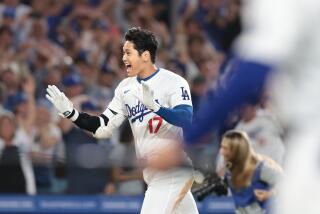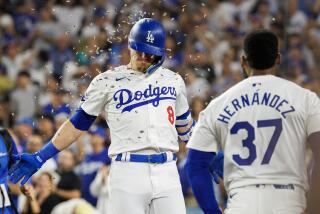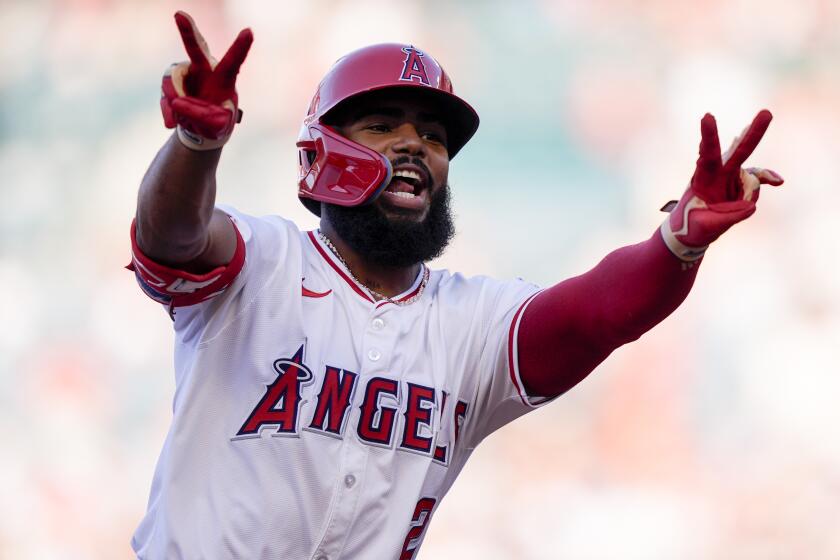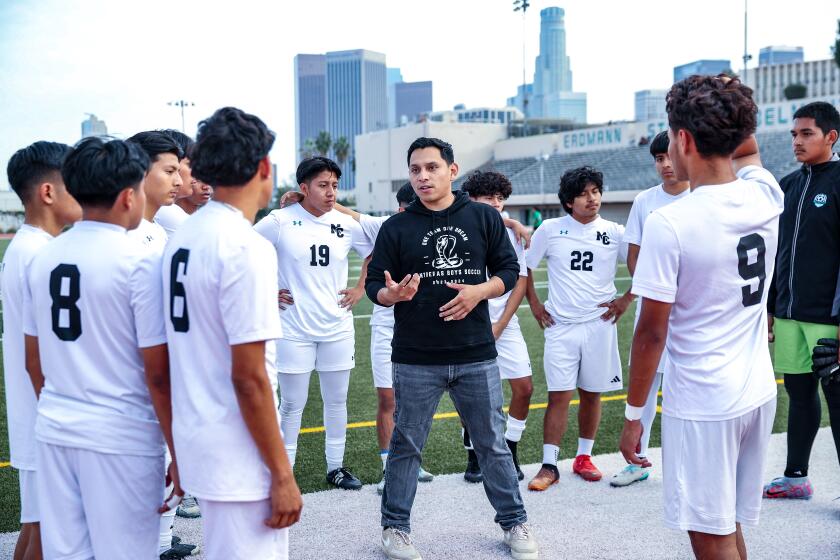POWERFUL PROMISE : Pirates’ Bobby Bonilla Is Making Name for Himself as Hitter in the Cepeda-Perez-McCovey-Stargell Mold
- Share via
PITTSBURGH — It’s not often that a young player reminds baseball’s elders of Tony Perez and Orlando Cepeda.
When you’re 6 feet 3 and swish the bat menacingly across the plate in a low golfer’s arc, then rock back, hands low, swaying just a touch to some internal rhumba, it brings back memories of those great right-handed line-drive hitters. Maybe it’s that ‘round-a-corner cock of the head, too, and that front shoulder tucked a bit more than normal. Mostly, though, it’s the sound -- cruuunch -- when bat compresses ball.
It’s just as rare when a player reminds the game’s oldsters of both Willie McCovey and Willie Stargell. When you weigh 230 pounds, all of it young and hard at 25 years old and, somehow, you also manage to get every ounce of that tonnage into your towering drives, it brings back to mind those upper-deck clouts of the mammoth Willies. It helps to make the connection if you and Stargell are also the only left-handed hitters ever to put a ball in the cheap seats in Three Rivers Stadium. For that, they paint your number on the chair.
What is truly exciting in this tradition-loving baseball town, with those nine National League pennants dating back to 1901, is that the Pirate player who reminds folks of Perez and Cepeda, McCovey and Stargell is not two men but just one.
Bobby Bonilla.
Switch-hitter. Third baseman. Cleanup hitter for the second-place -- yes, second-place and serious about it -- Pirates. Reigning National League player of the month. Scourge of the circuit.
Those weren’t typographical errors in the major-league-leaders agate in your morning newspaper. Bonilla’s name late last week stood first or tied for first in the NL in home runs, RBI, runs, hits, doubles, slugging percentage, extra-base hits and everything else except parking tickets. Oh, he was hitting .350, which is second in the league. We won’t bother with full-season projections because they’d be ridiculous, especially for a third-year player whose stats last year in his first full test were a very nice, but far from stunning, 15 homers, 77 RBI and a .300 average.
What makes Bonilla fascinating, aside from his hellacious first five weeks, is that normally sensible people fall over sideways when they talk about him. He’s getting the NL equivalent of the Jose Canseco-Mark McGwire treatment in the American League.
“I’m not a media-hype guy. I don’t make a lot of quotes. I don’t like to predict things,” says Pirates Manager Jim Leyland. “But I say that, within two years, Bobby Bonilla will be one of the premier players in the game.”
Then Leyland smiles, cat-and-mouse, and says, “Maybe sooner.
“Bobby’s big and has great power from both sides of the plate. He’s got a great arm. He’s quick. His foot speed is okay and he’s a pretty good base runner. He’s always been kind of laid-back (off the field), but he plays pretty gutsy. If I were him, I wouldn’t worry. I’d go ahead and buy a house here in Pittsburgh.”
What gives the Bonilla story weight is the Bonilla personality. The majority opinion can be summarized by Pirates catcher Mike LaValliere: “He’s one of the nicest guys you’ll ever meet.”
Bonilla is the sort of player who, when he has a fever of 102 degrees and can’t start, comes into the game in the late innings, as he did last week, to get a vital double and make two fine defensive plays. “If it wasn’t for the temperature and the headache, I could have started,” apologized Bonilla, who should have been home in bed. “When I got to second base (on the double), I almost threw up.”
Next day, Bonilla was back in the lineup. In every sense. Between coughs and aspirin, he obliged reporters with long interviews as befits a mega-mega. And, a day later, when he should have been drained, he hit a three-run home run off Orel Hershiser, who was 6-0 until he met Bonilla.
“Bonilla and (second baseman) Jose Lind have the best frames of mind on the team,” says Leyland, who vows that neither ever sulks, doubts himself or fails to give fair effort. “It’s a real special approach. Maybe when you’re good and you know it, you know things will turn around and go your way.”
Bonilla learned his baseball growing up in the tough South Bronx, almost in the shadow of Yankee Stadium. One at-bat he’d be Chris Chambliss left-handed, then he’d be Tommie Agee right-handed. However, Roberto Martin Antonio Bonilla learned his attitude from his father, an electrician. Although his parents were divorced, Bonilla’s dad spent plenty of time with him, even taking him on jobs. “Do you want to do this all your life?” his father would ask. Looking at the hard labor of the real world, Bonilla says he would answer, “No, sir. I want to play baseball for a living.”
Many will assume that Bonilla’s athletic road was a smooth and easy one because of his size and gifts. No. Nobody, but nobody, even tried to sign him out of high school. Bonilla, a slow bloomer, did better with home computers than curveballs, and even attended a technical college for a semester.
Then, along came Syd Thrift. Or, as the general manager is referred to in Pittsburgh, Your-Royal-Highness-Mr.-Genius-Sir. Thrift, then unaffiliated and conducting a clinic in Europe, tipped the Pirates to sign Bonilla. Then, five years later, when Thrift got the top job in Pittsburgh, he hornswoggled the Chicago White Sox out of Bonilla in a straight-up exchange for Jose (2-19) DeLeon.
Bonilla, like other raw and hulking young Buccaneers, such as Sid Bream (6-4, 220) and Randy “The Moose” Milligan (6-2, 230), came along slowly. But he never stopped coming. Bonilla’s .300 average authenticated him in ’87. Now that the Pirates have planted him at third base, instead of moving him between four positions (left, right, third and first base), Bonilla’s power has arrived, too.
“Bobby is just starting to realize what a dominant player he can be,” says LaValliere. “He’s so naturally talented offensively and he’s getting better and better at third base.”
In many ways, Bonilla’s progress parallels the Pirates’. He arrived, along wih Leyland, in 1986 when the Pirates “improved” from 104 losses to 98. “You got a standing ovation if you ran a ball out in 1986,” says Leyland. “Actually, I was as proud of that team as I am of this team. They played their butts off. That’s all I can ask.”
Last season, both Bonilla and the Pirates (80-82) turned the corner.
Now, everybody and his uncle is predicting wildly wonderful things here. Go in a bar and the first conversation you overhear is about how Bonilla “has a legitimate chance at the triple crown.” Fortunately, Bonilla, Leyland and the Pirates are taking the fancy stats -- like a 49-22 record from last Aug. 24 through this May 15 -- with several grains of salt.
“I know what I got. A good young baseball team,” says Leyland. “We just want to play our best and see what happens.”
More to Read
Go beyond the scoreboard
Get the latest on L.A.'s teams in the daily Sports Report newsletter.
You may occasionally receive promotional content from the Los Angeles Times.










